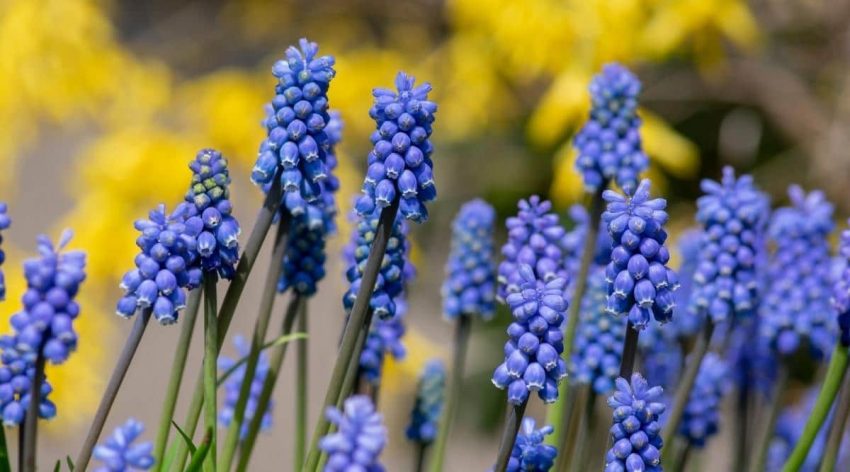langerhanscellhistiocytosis.org – The Grape Hyacinth (Muscari) is a delightful spring-blooming bulb known for its clusters of tiny, bell-shaped flowers that resemble bunches of grapes. These hardy, easy-to-grow plants are loved by gardeners for their vibrant blue, purple, and white hues that brighten up garden beds and borders early in the season. In this article, we’ll explore the beauty, care, and benefits of the Grape Hyacinth flower.
Characteristics of the Grape Hyacinth Flower
Grape Hyacinths are low-growing, compact plants, typically reaching heights of 6 to 9 inches. Their most distinctive feature is the dense, spike-like cluster of small, tightly packed flowers that bloom in shades of blue, purple, or white. The flowers have a sweet, mild fragrance that attracts pollinators, such as bees and butterflies.
These perennials bloom in early to mid-spring, creating a striking display of color. Their grass-like, narrow leaves emerge in the fall and remain green throughout the winter, making them one of the first plants to grace the garden with life after the cold months.
Ideal Growing Conditions
Grape Hyacinths are extremely versatile and easy to grow, making them a popular choice for gardeners of all skill levels. Here are some key care tips for cultivating healthy and vibrant plants:
- Sunlight: They thrive in full sun to partial shade. While they prefer plenty of sunlight, they can tolerate some shade, especially in warmer climates.
- Soil: Well-drained soil is essential for preventing bulb rot. Grape Hyacinths adapt to a range of soil types but grow best in moderately fertile soil.
- Watering: Once established, Grape Hyacinths require minimal watering. They are drought-tolerant and can handle dry conditions, especially in the summer when they go dormant.
- Planting: Plant the bulbs in the fall, about 3 inches deep and spaced 3 inches apart. They naturalize easily, meaning they will spread and multiply over time, creating a beautiful carpet of color.
Benefits of Planting Grape Hyacinths
Beyond their beautiful blooms, Grape Hyacinths offer several advantages that make them an excellent choice for gardens:
- Early Spring Color: Grape Hyacinths are one of the earliest flowers to bloom in the spring, adding a splash of color to gardens when many other plants are still dormant.
- Pollinator-Friendly: The fragrant flowers attract bees, butterflies, and other pollinators, supporting the health of your garden ecosystem.
- Low Maintenance: Once planted, Grape Hyacinths require little care and will return year after year, spreading naturally and creating larger displays over time.
- Versatile Use: Grape Hyacinths are perfect for garden beds, borders, rock gardens, and container plantings. They also work well as companion plants for other spring bloomers like tulips, daffodils, and crocuses.
Creative Planting Ideas
Grape Hyacinths look stunning when planted in large drifts or clusters. Their compact size makes them perfect for edging pathways or filling in gaps between larger plants. They also pair beautifully with other spring bulbs, creating a colorful and layered garden display. For a dramatic effect, consider planting different varieties of Grape Hyacinths to showcase their various shades of blue, purple, and white.
Conclusion
The Grape Hyacinth is a charming and reliable spring flower that brings a vibrant splash of color to gardens and landscapes. Its easy-to-grow nature, fragrant blooms, and ability to naturalize make it a must-have for gardeners seeking early-season beauty. Whether used in borders, containers, or naturalized areas, Grape Hyacinths are sure to brighten up any outdoor space year after year.

